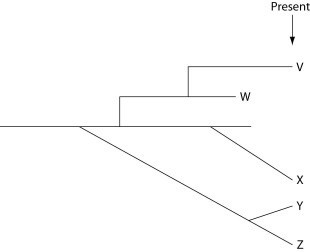Multiple Choice
The next few questions refer to the following evolutionary tree, whose horizontal axis represents time (present time is on the far right) and whose vertical axis represents morphological change.

-Which conclusion can be drawn from this evolutionary tree?
A) Gradualistic speciation and speciation involving punctuated equilibrium are mutually exclusive concepts; only one of them can occur.
B) Eldredge and Gould would deny that the lineages labeled X, Y, and Z could represent true species.
C) Assuming that the tip of each line represents a species, there are five extant (i.e., not extinct) species resulting from the earliest common ancestor.
D) A single clade (i.e., a group of species that share a common ancestor) can exhibit both gradualism and punctuated equilibrium.
E) V and W shared a common ancestor more recently than any of the other species.
Correct Answer:

Verified
Correct Answer:
Verified
Q38: A hybrid zone is properly defined as<br>A)
Q39: The predatory fish rely on visual cues
Q40: In a hypothetical situation, the National Park
Q41: What is true of macroevolution?<br>A) It is
Q42: The difference between geographic isolation and habitat
Q44: The origin of a new plant species
Q45: Dogs (Canis lupus familiaris)and gray wolves (Canis
Q46: Two species of frogs belonging to the
Q47: The next few questions refer to the
Q48: Rocky Mountain juniper (Juniperus scopulorum)and one-seeded juniper